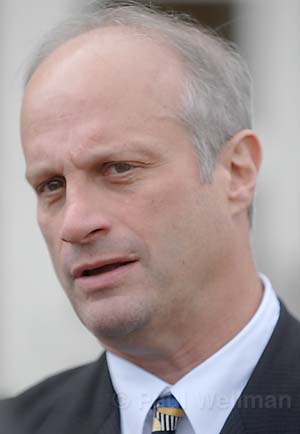News-Press Trial Taking a Break
Illegible Bargaining Table Notes Create Impasse
For approximately an hour, I was under the thrilling misconception that the most recent trial pitting the National Labor Relations Board (NLRB) against the News-Press would soon be coming to a close – alas, it was not to be. Having sat in on a smattering of mornings and afternoons down at the Santa Barbara College of Law, I got the distinct impression that all of the lawyers involved – defense, general counsel, and charging party, not to mention Judge Clifford Anderson – were ready for the trial to be over, too.
On Wednesday, July 15, the end didn’t look very far away. The defense’s final witness, Yolanda Apodaca, the News-Press‘s director of human resources, had taken the stand to answer questions about temporary employees, job descriptions, firings, and hirings. When Apodaca, one of only 16 witnesses, was dismissed at the end of the morning session, it seemed only a few loose ends remained to be tied, concerning the submission of a handful of final documents to the body of evidence.

Upon returning after lunch, lawyers expressed high hopes of quickly submitting the evidence and leaving early for the afternoon. Unfortunately, the final documents-a series of articles published by the News-Press, a collection of employee-performance evaluations from 2004 and 2005, and handwritten notes taken at the bargaining table-sparked too much controversy between the charging party and the defense to be quickly and efficiently submitted into evidence.
Due to the nature of this trial, in which the NLRB is charging the News-Press with unfair labor practices-notably the newspaper ownership’s failure to negotiate in good faith during two years at the bargaining table, and also the retaliatory firing of sportswriter Dennis Moran, who was on the newsroom bargaining committee-much of the evidence is in document form.
Instead of legitimizing the documents through the testimony of witnesses, all parties involved have to agree that the documents are what they purport to be, without objections. Much of the time-with reams of performance evaluations, time cards, articles, and the like-this process has been a quick, easy, and relatively painless one. However, the handwritten bargaining notes brought by the defense did not make it through the process so easily.
Portions of notes written by Dawn Hobbs, a member of the negotiating team and one of several reporters fired during union organizing battles at the paper, were virtually illegible and therefore provide a special challenge to all lawyers intending to use them as evidence. Not only do they provide room for interpretation, as any other document would, it also seems that translation will play a significant role, as all parties attempt to decipher the pages of chicken scratch with no guaranteed fidelity to the author’s real meaning. (Illegibility is a common characteristic of reporters’ notes.)
Teamsters’ Union attorney Ira Gottlieb, representing the newsroom employees, said that the union side turned over many sets of notes, while the News-Press turned over a consolidated version of their collective sets of notes, having destroyed the originals.
After a significant period of off-the-record discussion about the notes and attempts at negotiations, it became clear that the charging party and the defense would be unable to reach an agreement. Judge Anderson deemed it the best course of action to take a break until August 11. In the meantime, all parties are expected to inspect the notes and come to some sort of agreement, which might entail calling the author of the notes as a 17th witness, so that the trial can eventually come to a close.



